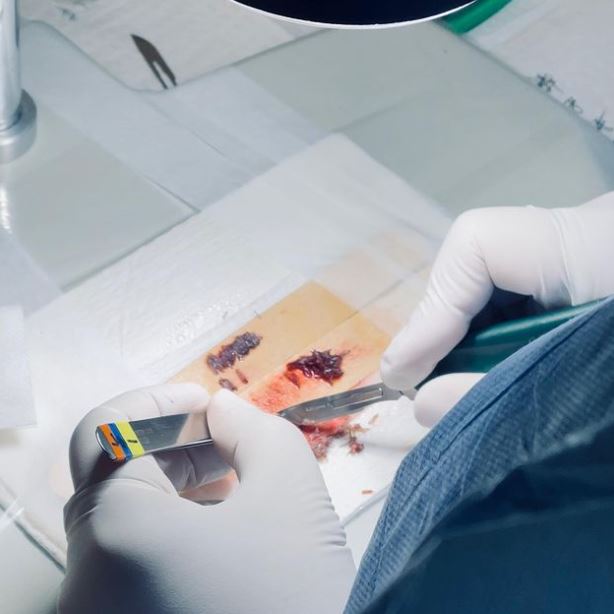The Role of FUT Procedures in the Overall Hair Restoration Treatment Plan

The Role of FUT Procedures in the Overall Hair Restoration Treatment Plan Many hair transplant clinics only offer FUE – especially plastic surgeons who buy the robot or only do Neograft as an add-on surgery. Additionally, FUE is not usually recommended for women because it requires shaving the entire back and sides of the head – something that most women do not want to do — and women typically do not have the same donor density as their male counterparts. At Ziering Medical, we perform both FUT and FUE hair restoration. Our surgeons will recommend what procedure is best for each patient at their particular stage of hair loss.
What is MFUT (MDEE) Hair Transplant Surgery?
Microscopic Follicular Unit Transplant or more accurately known as Microscopically Dissected Elliptical Excision (MDEE), involves removing a strip of tissue from the donor zone, usually on the back and sides of the head, and transplanting the individual follicular units into the recipient areas. While hair transplant surgeons have been doing FUT surgeries in the past, the all-purpose microscopes used for microscopic follicular unit grafting were inadequate. The images and the overall viewing size were too small for Dr. Ziering’s expert hair transplant techniques. Today, the Ziering Medical Team uses the Ziering Scope, Dr. Ziering’s own invention, to see follicular units in better detail. The Ziering Scopes have a broad field of illumination, giving a bigger and better view of the grafts which helps reduce the graft transection rates. They also use cool heat versus warm/hot heat to prevent the grafts from drying out. Cool heat increases graft survival rates and ensures optimal surgical outcomes.
How It’s Done
For MDEE, your surgeon will begin the procedure by determining and removing the donor strip/tissue and dissecting it into follicular units using the Ziering Scope. After harvesting the donor hair, the surgical techs will dissect the grafts into their naturally occurring follicular unit of 1 – 4 hairs. Once that’s done, your surgeon will begin creating the recipient sites for the grafts according to the agreed hair transplant design. The recipient sites have to be made at the precise angle, direction, and orientation so your surgeon’s artistry is crucial in creating these sites to achieve excellent results. And because every patient has finite donor hair, your surgeon has to consider the best use of the donor hair to create the illusion of more hair in all the balding and thinning areas. Finally, the hair transplant technicians will gently place the grafts into the recipient sites at the proper angle and orientation. MDEE is performed on an outpatient basis and is done under local anesthesia, so you can return home once the procedure is complete.

CAPTION: Once the donor tissue is removed, it is transported to a microscope where it will be meticulously divided and dissected into follicular units. This process requires significant skill and technique as the grafts can easily become damaged if mishandled.
Benefits of Microscopic Follicular Unit Transplant
MDEE has made a world of difference in hair transplant technology. It has greatly improved the survival rates of hair grafts and the overall aesthetic results of hair restoration surgery. MDEE allows for the harvesting of a large number of grafts in one session. It is arguably the most efficient way to obtain a significant amount of hair in a short period of time. Because of this, it’s ideal for patients looking for a dramatic change in one procedure and is also recommended for women who most likely do not want to shave the back and sides of their heads for the donor harvest step of the hair restoration procedure. MDEE also offers “super sessions,” allowing up to 4,000 or more follicular units to be transplanted in one surgery vs FUE, which typically allows 2,000 – 2,500 follicular units to be transplanted. In addition, patients who have MDEE as their first surgery may opt to have an FUE for their second surgery or vice versa to maximize their donor yield.
MDEE Before and After

This patient received excellent results from his MDEE procedure and has a fully healed, with a nearly invisible, inconspicuous linear scar.
This patient was able to add more density on top of his hairline using the MDEE hair transplant technique. See more beautiful B & A photos like this. Experience the Ziering Hair Transplant Artistry Your results rely on your surgeon’s experience, skill, and artistry. Top hair transplant surgeons have a long list of satisfied patients and beautiful before and after photos. If you’re considering a hair transplant surgery and want to ensure that you’re getting the best service you can get, call us to schedule a consultation at Ziering Medical. The Ziering Medical Team will take care of you from start to finish. We serve patients all over the greater Tri-state area of New York, New Jersey, and Connecticut as well as the greater Southern California area from Los Angeles and Beverly Hills to Newport Beach and San Diego.
